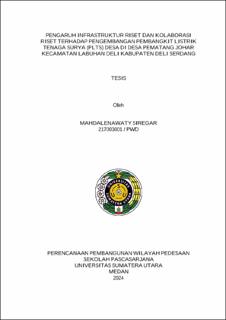| dc.description.abstract | This research aims to: (1)to know the influence of Research Infrastructure on the
Development of Solar Power Plants (PLTS); (2) to know the influence of Research
Collaboration on the Development of Solar Power Plants (PLTS); and (3) to know the influence
of Research Infrastructure and Research Collaboration on the Development of Solar Power
Plants (PLTS).
The method in this research uses quantitative research withwith an associative
explanatory research model, namely research that aims to determine the relationship between
two or more variables.The subjects of the study were the community and related institutions in
the Pematang Johar Village Environment, Labuhan Deli District, Deli Serdang Regency, North
Sumatra Province, such as: the Department of Industry, the Department of Trade, Energy and
Mineral Resources of the North Sumatra Province, Pertamina and the Deli Serdang Regency
Government. The population in this study was the community and related institutions in the
Pematang Johar Village Environment, Labuhan Deli District, Deli Serdang
Regency.Determination of the sample based on a survey at the beginning of the study obtained a
population of 120 (one hundred and twenty) people/participants. The data analysis method used
is multiple regression analysis.
The results of this study are: 1) there is an influence of research infrastructure (X1) on
the development of PLTS (Y); (2) there is an influence of research collaboration (X2) on the
development of PLTS (Y); (3) There is a direct and significant influence of research
infrastructure (X1) and research collaboration (X2) on the development of PLTS (Y) with
significant results.
The development of Solar Power Plants (PLTS) in villages such as Pematang Johar,
Labuhan Deli, Deli Serdang Regency requires a comprehensive approach. The availability of
adequate research infrastructure and collaboration between research institutions, government,
and local communities are very important in supporting innovation and implementation of
PLTS that are in accordance with local needs. Village PLTS has the potential to increase
access to clean energy, support economic and social development, and increase energy
independence. To accelerate this development, strong support from the government is needed in
the form of policies, incentives, and budget allocations. Sustainability aspects, including routine
maintenance, operator training, and active community participation, must also be considered to
ensure effective long-term PLTS management. | en_US |


